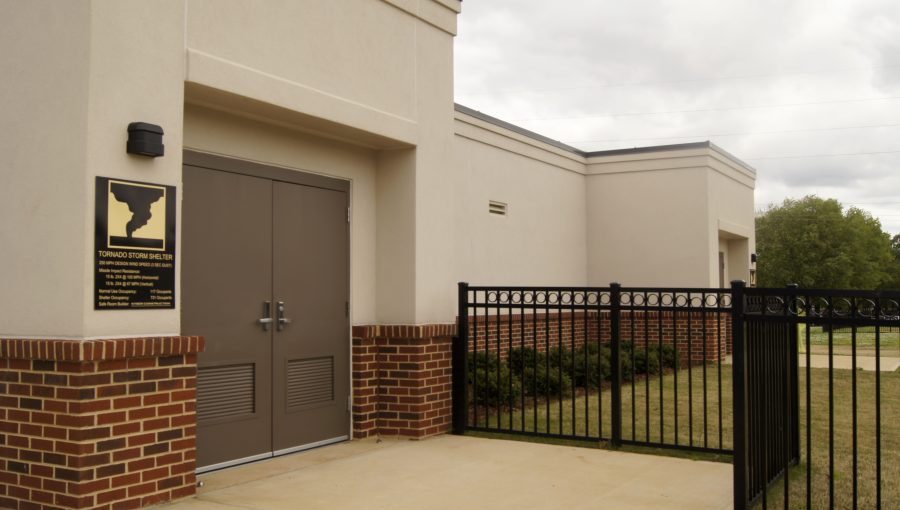When the tornado swept through Tuscaloosa in April of 2011, the University and the city each had the same number of public storm shelters for students and residents: zero.
“At the time of the tornado, we really didn’t have [shelters], other than some individual storm shelters within the city of Tuscaloosa. I don’t know that we really had done a very good job of even anticipating the need for them so there really was not a number of public shelters,” said Robin Edgeworth, director for the Department of Resilience and Innovation.
In the wake of the tornado, Edgeworth said Tuscaloosa began to incorporate shelters into the buildings that were reconstructed, and within newer schools.
“We, the city itself, did not construct any like per se storm shelters,” she said. “We built back a number of our buildings and incorporated within them storm shelters. Most of those have been built to accommodate the number of people that the city has on site. So when we built back our Environmental Service Building, it is built with a storm shelter large enough to handle the number of environmental service people [in the building],” she said. “We did that within every building we built back.”
Tim Leopard, associate vice-president of construction at the University, said the University used Best Available Refuge Areas (BARAs) before the tornado, which are essentially safe spaces during inclement weather. However, Most BARAs do not necessarily measure up to FEMA code ICC500 to qualify as a storm shelter.
“ICC500 FEMA 361, the code is very prescriptive, very detailed as to the structure that it takes and the loads that the facility could see from a tornadic event,” Leopard said. “A BARA can be a structure, well, in a manner, that will hold up, but it maybe doesn’t meet some of the other prescriptive codes of ICC500.”
Donald Keith, director of emergency preparedness at the University, said despite the lack of FEMA rated shelters in 2011, the University was storm-ready certified by the National Weather Service.
“We had achieved that designation, so we had it before the tornado struck, so that meant our systems, our protocols, our communications, our warning systems, [they] all met a particular standard as designated by the Weather Service,” he said. “To this day, we’ve had it renewed so we’re still are maintaining those standards.”
Following the Enterprise Tornado in 2007, former Governor Bob Riley signed House Bill 459 into law, requiring safe spaces in K-12 institutions. Then in May 2012, Governor Robert Bentley signed House Bill 427 requiring the same shelters in community colleges and public universities across the state. Since that time, the University has begun construction on three storm shelters across campus, and that’s not the only improvement the University has made.
“We have more dedicated storm shelters that weren’t in place at that time, that’s one of the changes,” Keith said. “We’ve got our own weather station on campus so that we can better understand what the conditions are on our campus as opposed to getting it from other locations… And we have emergency plans to open those shelters up not just for tornado warnings, but now we’re opening them up, staffing them during a tornado watch.”
Two of the three new storm shelters are already up and running at the Presidential Village Student Activity Center and on the east side of campus behind the Child Development Center. Leopard said the newest shelter will be a new classroom facility, which will be completed in time for August classes and have the capacity for roughly 2,000 people.
Nicole Gardner, a freshman majoring in biology and psychology, lives in Presidential Village and said living so close to the storm shelter makes her feel safer should severe weather strike again.
“Because we live on the fifth floor, it’s nice knowing that in a matter of a minute we could be down [in the shelter] and underground… It’s nice having it really close by just in case,” she said.
The University’s emergency management program was accredited in 2015 by the Emergency Management Accreditation Program (EMAP) and is one of three universities in the country to receive this distinction. EMAP is the only accreditation process available for emergency management programs in colleges and universities.
Edgeworth said even though Tuscaloosa is providing public shelters, individual storm shelters are the safer approach for everyone since public shelters tax public resources during an emergency.
“In public storm shelters you have to commit to the operations of those. So that means you have to have a hard plan on how you’re going to, when you’re going to open them, how long they’ll stay open, and then how to transition people out of them,” she said. “You don’t want people moving. You don’t want them on the road under a warning.”
Edgeworth said to prepare for future weather, everyone should have a plan and be weather aware. She said it is important to know where the location of the closest shelter before the weather hits.
The city of Tuscaloosa recently created an alert system like the UA emergency call system to help prepare residents in case of an emergency.
“We have also developed what we call our Emergency Alert System and when there is a warning it automatically will call you if you’re within that polygon and alert you that there is a warning, and we encourage people, if you’re not getting that call, make sure you call us to find out why you’re not,” she said.
For more information on what to do in an emergency, people can check prepare.ua.edu to learn about the shelters and BARAs nearby to create a plan before severe weather strikes again.







